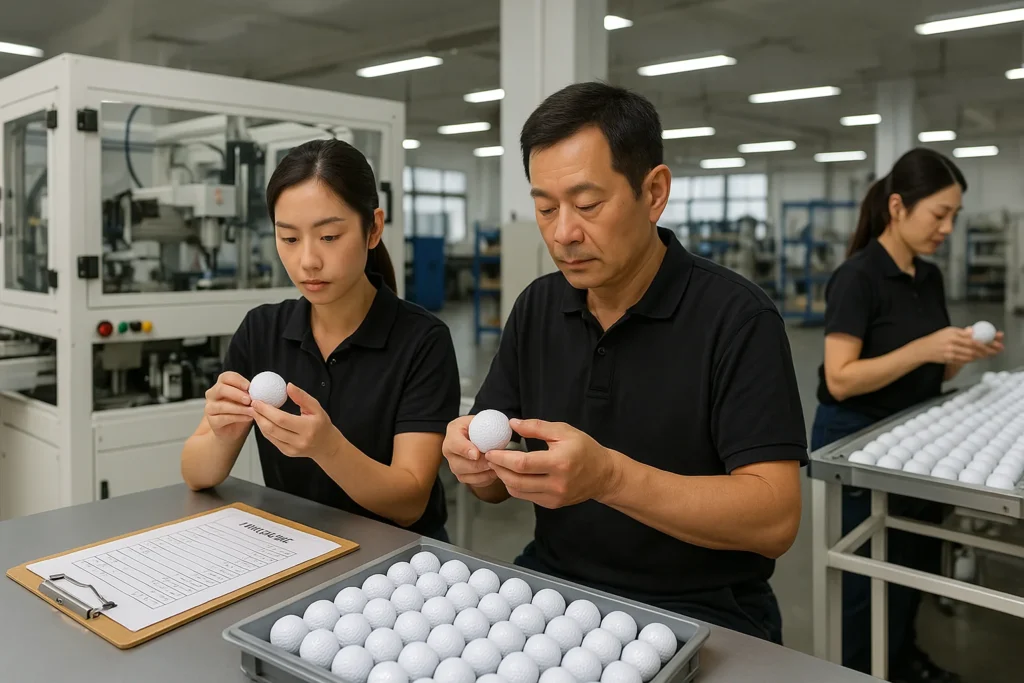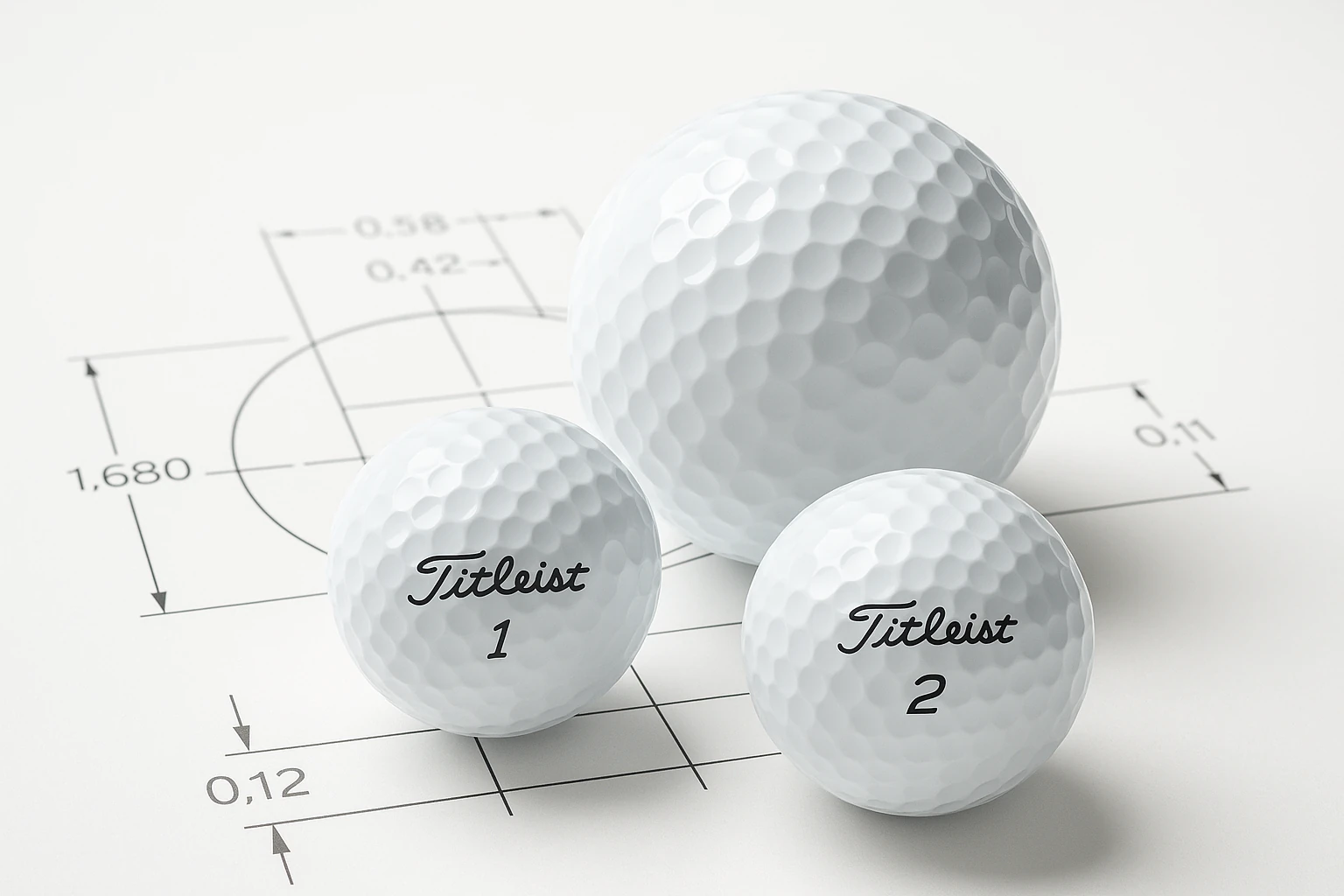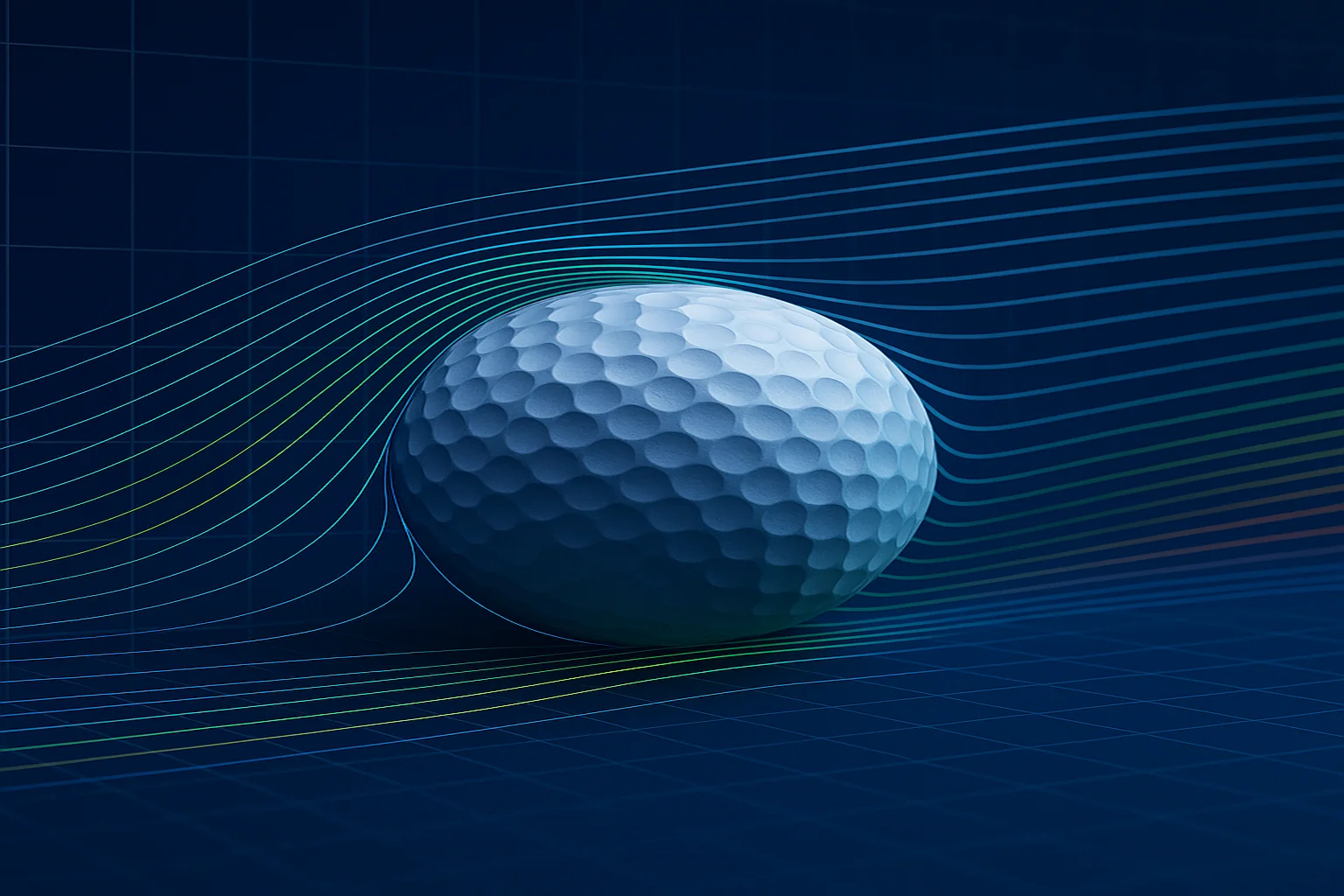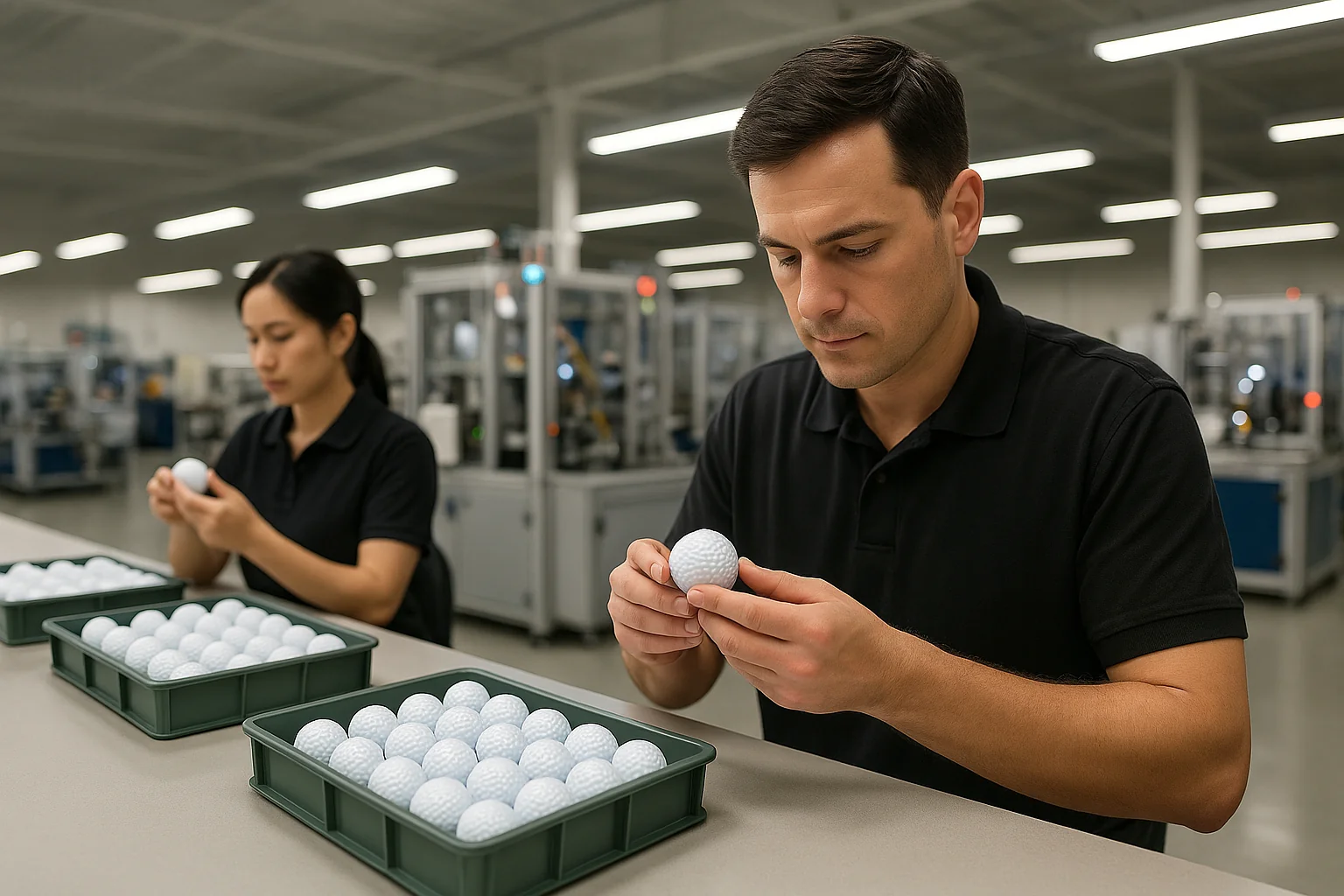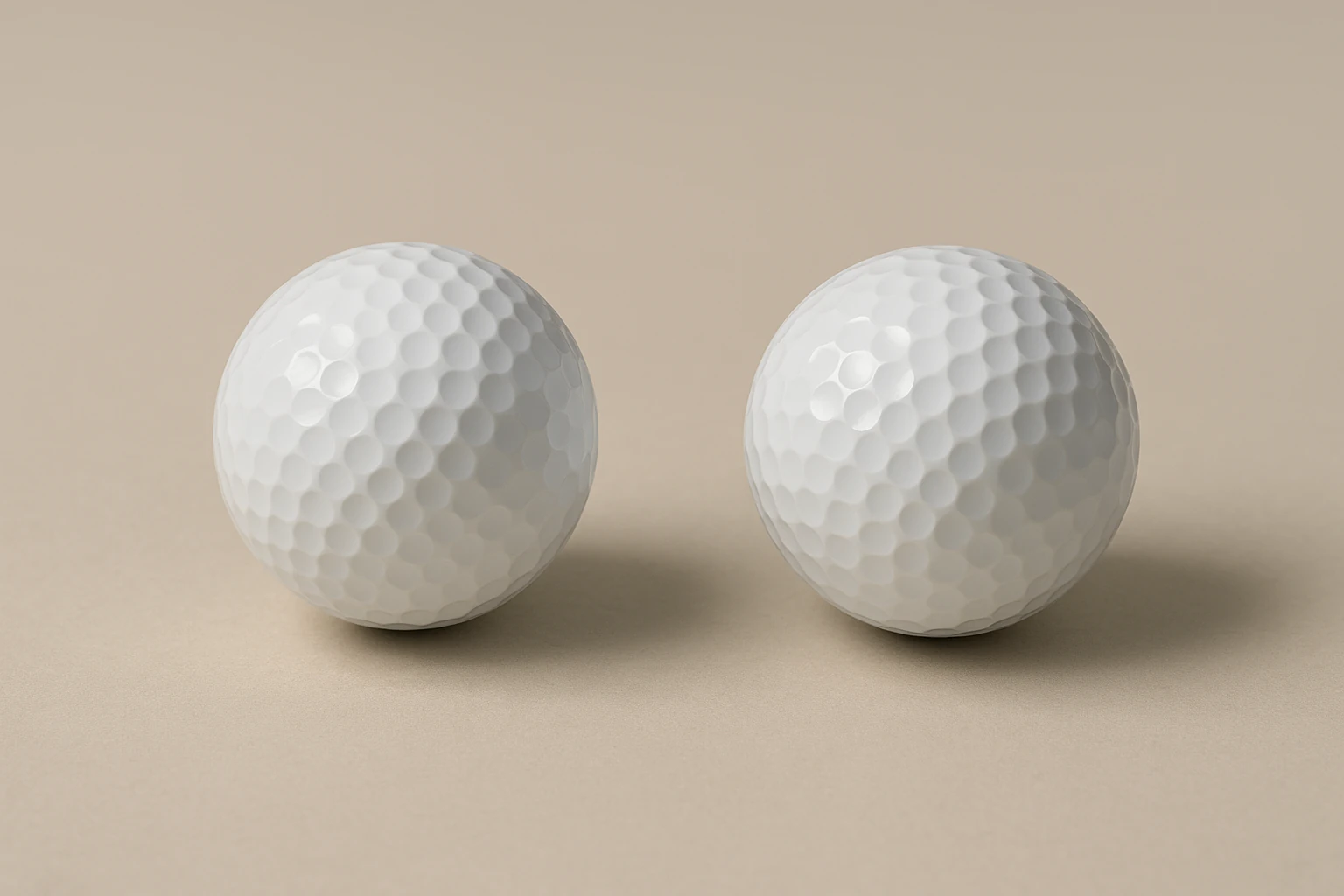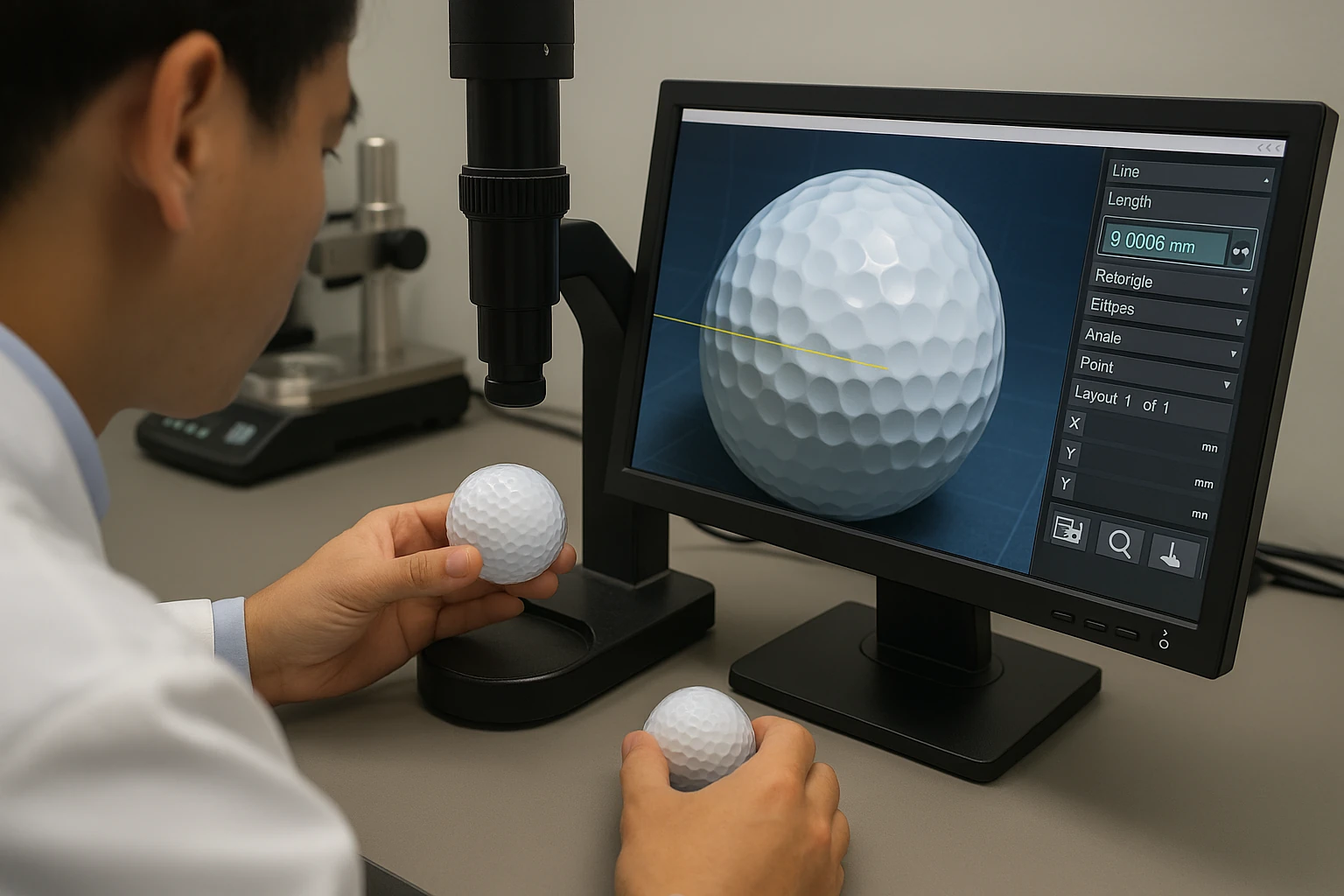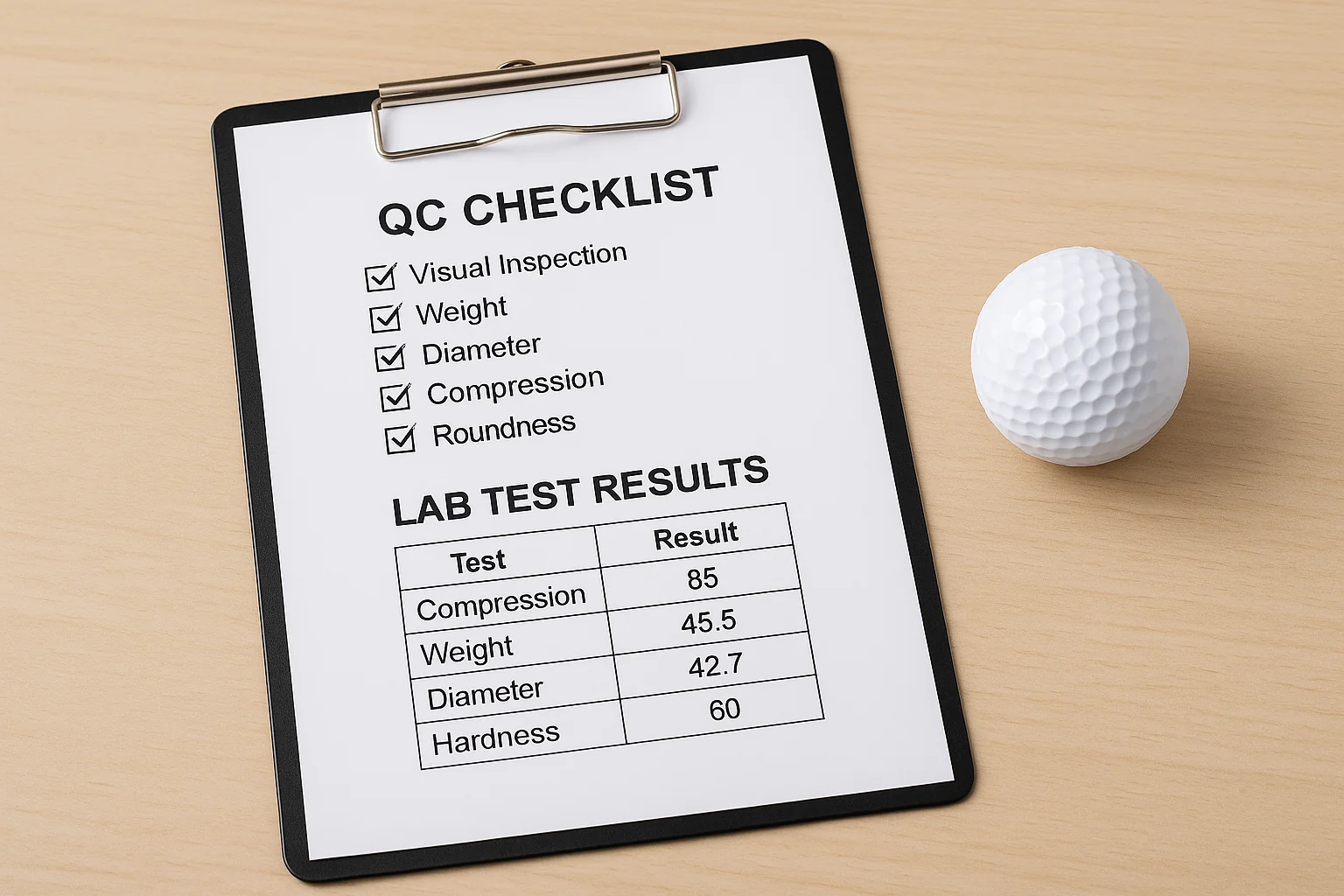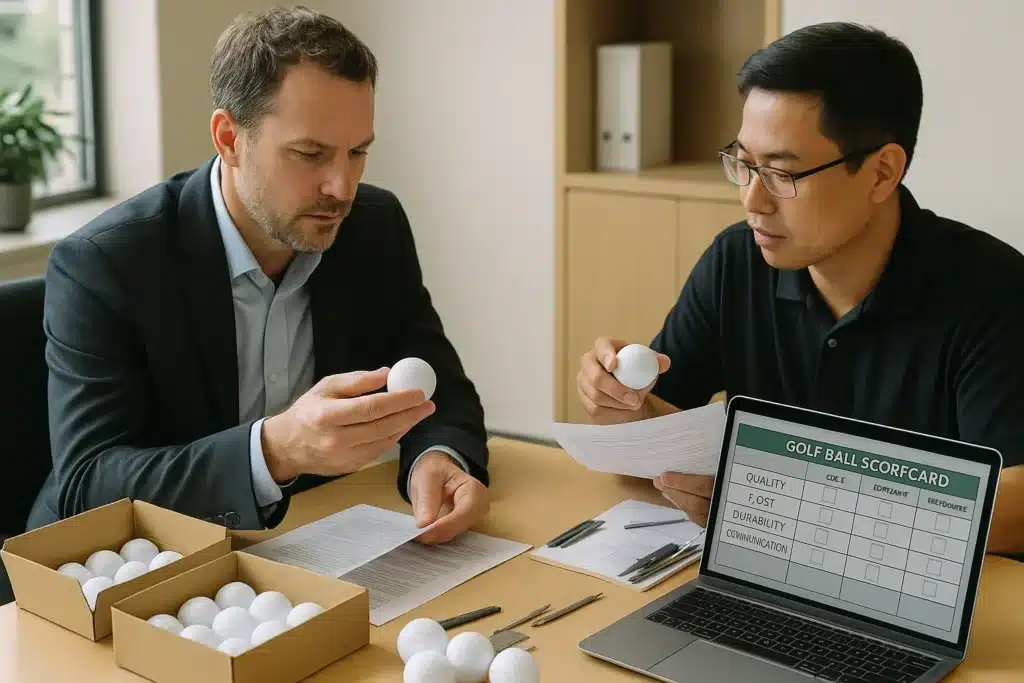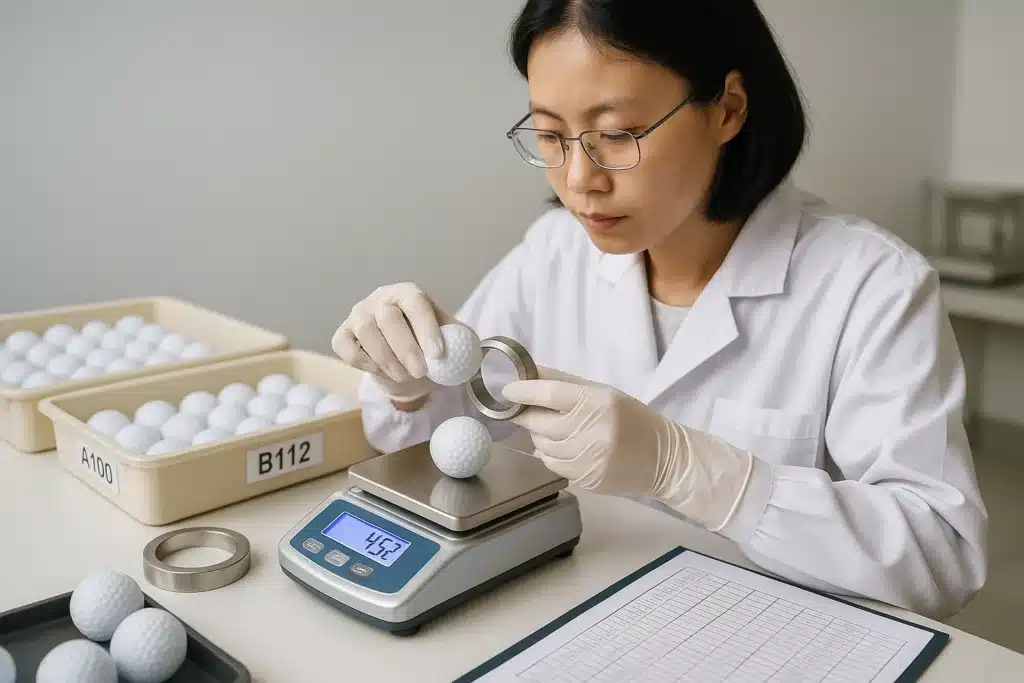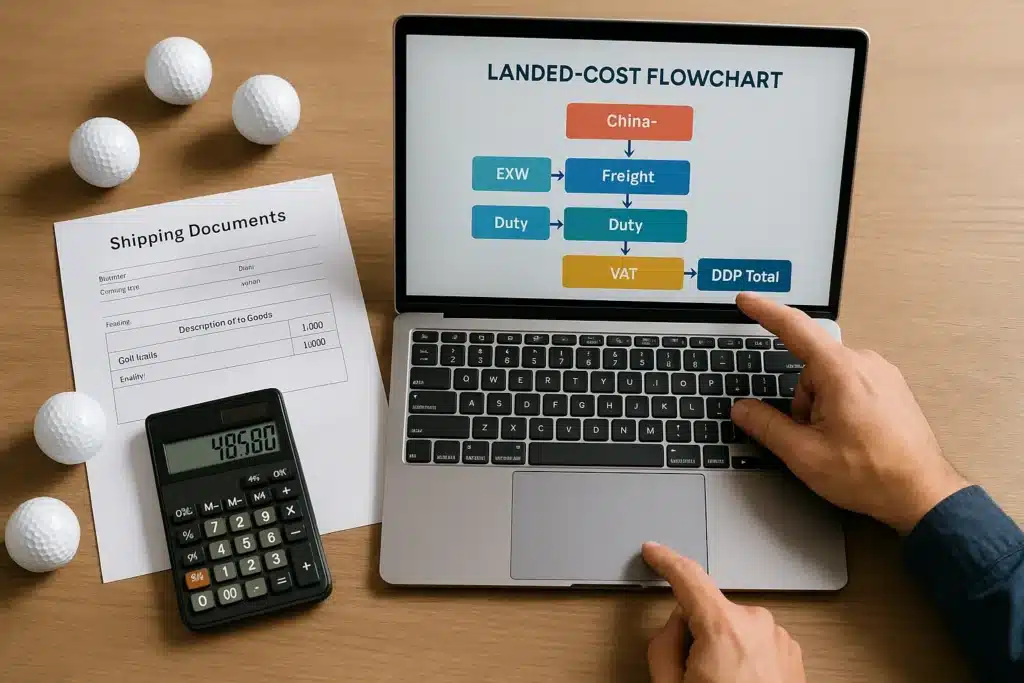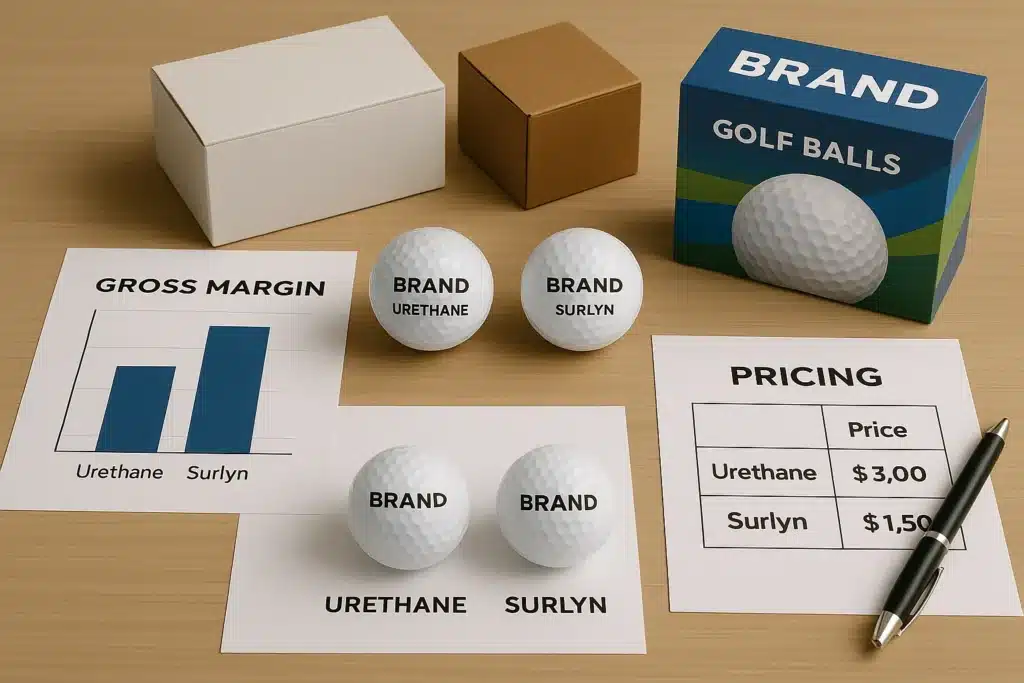Lately, we’ve received a growing number of inquiries from clients asking: “Can you manufacture golf balls at the level of Titleist Pro V1 or Pro V1x?” Many were told—at trade shows or via supplier outreach—that some Chinese factories can deliver “Tour‑level” balls. While this sounds promising, it comes with caveats. This Q&A gives you a decision‑ready view: technology barriers → current capabilities → OEM buyer actions.
Yes, Chinese factories can manufacture golf balls that visually and tactically resemble Titleist Pro V1 and Pro V1x—but most fall short in four core areas: gradient core design, ultra-thin cast urethane consistency, sub-0.02 mm layer precision, and proprietary aerodynamic IP. While a few reach 60–70% of Pro V1 performance, full Tour-level replication requires integrated R&D, advanced materials, and tighter process control.
What makes Pro V1 and Pro V1x so hard to replicate?
Pro V1 and Pro V1x are tough to copy because they integrate gradient‑compression cores, ultra‑thin cast urethane covers (≈0.5–0.6 mm), ±0.02 mm layer control, and CFD‑optimized dimple systems. You can mimic the look; repeatable Tour‑grade spin, distance, and dispersion require precision and IP that most factories don’t yet have.
Gradient core: the hidden engine behind performance
A gradient core varies hardness from center to edge to balance ball speed and spin control; most low‑cost lines mold uniform cores that can’t hit the same spin windows. Soft center for speed, firmer outer for stability—that’s why Pro V1 level golf balls feel lively yet controllable. The chemistry (additive dispersion, cure kinetics) is the hard part.
Cast urethane cover: thin, durable, and expensive
Cast urethane delivers high greenside spin and soft feel at thin gauges, but liquid casting has narrow temperature/viscosity windows and tight demold timing. Chinese plants fluent in TPU/Surlyn see yield loss when shifting to thin cast urethane—voids, micro‑tears, or thickness drift—hurting golf ball consistency and durability.
Layer control: it’s not just about layer count
Tolerances drive flight repeatability: Tour ball specifications target ±0.02 mm concentricity; many Chinese builds sit at ±0.05–0.08 mm. The difference compounds over 250–300 yards, widening dispersion and altering spin.
Aerodynamics and patented dimple systems
Titleist’s CFD libraries tune dimple depth, edge radius, and layout for stability through wind. Generic or copied maps can look similar yet fly differently—especially in crosswinds—so “Titleist alternatives” without original aerodynamics won’t match real‑world flight of Pro V1 level golf balls.
What can Chinese golf ball manufacturers currently produce?
Chinese factories excel at volume two‑piece Surlyn balls and increasingly competent three‑piece TPU/PU models. Only a handful pilot thin cast urethane programs. For most amateurs, these offerings feel premium at a value price; versus Pro V1, the gaps are greenside spin, wind stability, and golf ball consistency batch‑to‑batch.
Tier 1: two‑piece Surlyn balls for practice and promotions
Large cores with Surlyn covers dominate ranges, giveaways, and big‑box retail—durable and low cost. Performance is straightforward: firm feel, low spin, good distance. Not designed for Tour ball specifications or nuanced short‑game control.
Tier 2: mid‑range three‑piece balls with TPU/urethane skins
A mantle moderates spin/feel while TPU or thicker PU adds softness and bite—ideal for 10–25 handicaps. Dongguan, Ningbo, and Xiamen clusters lead here. These are credible Titleist alternatives for value‑premium segments but still short of Pro V1 level golf balls in greenside spin and wind robustness.
Tier 3: experimental Tour balls from R&D‑driven factories
Small pilots using cast urethane and 3–4 layers can hit 70–80% of Pro V1 benchmarks in lab tests, yet struggle at scale with yield and aerodynamic IP. Validate with compression maps, cutaways, and wedge‑wear tests.
What Chinese factories can do well (quick list)
Process scale, cost engineering, and cosmetic execution are strengths; thin cast urethane, gradient cores, and proprietary dimples are the stretch goals.
- High‑volume two‑piece output with tight CT on cores (for price‑point models)
- Consistent pad/UV printing and paint finish for retail‑ready looks
- Tooling agility for private‑label SKUs and packaging
- Fast sampling cycles for marketing pilots
Case study: Kirkland Signature & SM Parker—how close is “close”?
Kirkland urethane balls (SM Parker, Qingdao) offer premium feel and strong value, yet they trail Pro V1 in wedge‑spin control, wind stability, and long‑term cover integrity. Great for casual players and price hunters; not equal to Pro V1 level golf balls for elite play.
China Golf Ball Manufacturing Tiers vs. Performance
| Tier | Ball Type | Typical Structure | Cover Material | Estimated Performance vs. Pro V1 | Common Use Case |
|---|---|---|---|---|---|
| 1 | 2‑piece | Large core + Surlyn | Surlyn | 30–40% | Range balls, giveaways |
| 2 | 3‑piece | Core + mantle + TPU | TPU / thick PU | 60–70% | Mid‑range brands, amateur play |
| 3 | 3–4 piece (test) | Multi‑core + cast urethane | Cast urethane (pilot) | 70–80% (in theory) | Experimental OEM, R&D brands |
Can Chinese factories make four‑piece golf balls like Pro V1x?
Some suppliers advertise “four‑layer” balls, but most are structural look‑alikes rather than functionally equivalent. A real Pro V1x needs dual‑core behavior, a responsive mantle, an ultra‑thin cast urethane cover, and ±0.02 mm concentricity—standards seldom held at scale in current Chinese lines.
What “four‑layer” actually means in Tour balls
Just having four layers doesn’t make a Pro V1x. You need a true dual‑core system, a tuned mantle, and a thin cast urethane cover working together to shape the flight windows. Counting paint as a “layer” is marketing—not engineering.
Structural accuracy vs. marketing claims
Layer count matters only with tight thickness maps, roundness, and hardness gradients. A large core + inner shell + thick cover + paint can cut like four layers yet miss Pro V1x ball speed, trajectory, and wedge interaction.
What a real Pro V1x needs beyond layer count
A Tour‑grade four‑piece marries materials science with machining discipline: gradient cores, 0.5–0.6 mm cast urethane, and proprietary dimple IP. Without all three, you don’t get Pro V1 level golf balls in real play.
✔ True — Four‑piece design requires precise functional layering
Each layer in a Pro V1x serves a specific purpose: dual core for launch/spin control, mantle for energy transfer, and ultra‑thin cover for feel. Function matters more than layer count.
✘ False — “Any 4‑layer ball matches Pro V1x”
Many OEM balls stack layers without true performance function. Without gradient cores and cast urethane, layer count alone doesn’t deliver Tour‑level quality.
What are the key technical bottlenecks for China?
Gaps are engineering depth, not ambition: no production‑proven gradient core systems, limited mastery of thin cast urethane, wider variation in layer thickness, and a lack of proprietary dimple IP/CFD. Closing all four is the unlock for authentic Pro V1 level golf balls.
Gradient core formulation and curing
Additive dispersion, temperature staging, and cure kinetics must produce a smooth hardness transition. Miss one dial and you create banding that changes spin windows and curtails golf ball consistency.
Cast urethane yield and durability
Thin covers magnify upstream imperfections—flash, voids, shell wobble—so in‑line metrology and mold finish matter. Until yields stabilize, thin cast urethane programs risk scrap spikes and faster cover wear.
Aerodynamic IP and CFD toolchains
CFD‑driven dimple sets are tuned libraries validated over decades; public maps can’t match wind robustness. For credible Titleist alternatives, Chinese OEMs need original research and protected patterns—not templates.
Comparison — Pro V1 engineering vs. China OEM
| Feature | Titleist Pro V1 | China OEM Top Tier | Gap Description |
|---|---|---|---|
| Core Design | Gradient compression core | Single‑density core | Lacks hardness transition |
| Outer Cover | 0.5–0.6 mm cast urethane | 0.6–0.8 mm TPU or thick urethane | Thickness/consistency gap |
| Layer Control | ±0.02 mm | ±0.05–0.08 mm | Impacts flight & spin |
| Dimple Design | CFD‑optimized, patented | Generic templates | Lower aerodynamic stability |
Should you OEM Tour‑level balls from China?
Yes—if your target is the amateur or value‑premium segment and you manage risk with data. China can deliver “Tour‑style feel” at great value; claiming Pro V1 parity without evidence backfires. Use the checklist below to assess Tour ball specifications and golf ball consistency before scaling.
When OEM from China makes sense
OEM is smart when your brand aims for premium feel at mid‑market pricing, not a Tour contract. Specify softer compression, friendly launch, and usable wedge grip for 10–25 handicaps. Position as Titleist alternatives for value seekers.
What to ask suppliers before committing
Request evidence, not adjectives: compression distributions, cross‑section photos, cover thickness histograms, and USGA conformance. Ask about raw material sourcing (cast urethane vs. TPU), dimple origin (original vs. public map), and in‑process controls.
Why many “Pro V1 clones” fail under real testing
They often replicate cosmetics and layer counts but miss gradient cores, thin cast urethane, and tight tolerances—so wedge‑spin decays, wind dispersion widens, and cover wear accelerates. Lab speed numbers may look fine; on‑course dispersion exposes the gap.
OEM buyer checklist: verifying Tour‑level ball claims
| Criteria | Why It Matters | What to Request from Supplier |
|---|---|---|
| Compression rating | Affects feel and launch | Compression map or lab test |
| Material type | Determines durability/spin | Cast urethane spec sheet |
| Layer accuracy | Impacts consistency | Cross‑section diagrams |
| Dimple design | Affects aerodynamics | 3D model or airflow test |
| USGA conformity | Legal for competition | Ball conformance certificate |
✔ True — Test reports only cover a specific sample
Lab reports validate one batch, not entire production. Each shipment needs batch‑level quality control and possibly third‑party verification to ensure ongoing compliance.
✘ False — “They sent a report, so the whole shipment is fine”
Relying blindly on test certificates can be misleading. Real quality requires ongoing vigilance, not just one report.
So, can China match Pro V1 today or in the future?
Today, China delivers look‑alike urethane/TPU balls that satisfy many amateurs at ~60–75% of Pro V1 performance. To achieve parity, factories must master gradient cores, thin cast urethane, layer precision, and proprietary aerodynamics at scale. The gap is narrowing; engineering depth and durability are the remaining hurdles.
Short‑term reality (0–2 years)
Expect improving three‑piece offerings and more urethane pilots—market them as value‑premium, not Pro V1 equals. Run pilot lots and publish data‑backed claims.
Mid‑term outlook (3–5 years)
Better mold finish, in‑line metrology, and resin sourcing will cut scrap and tighten tolerances. Some OEMs may field stable four‑piece lines with improved wind robustness.
Long‑term scenario (5–10 years)
With sustained R&D and original dimple IP, parity is plausible and niche models could surpass parts of the Pro V1 profile. Brands that commit to iteration—not one‑off “clone” projects—will lead.
Key Takeaway Box
- Reality: 60–75% of Pro V1 performance is feasible today for amateur targets; full parity needs R&D + process breakthroughs.
- Most limiting: gradient cores, thin cast urethane yield, ±0.02 mm concentricity, and proprietary dimples.
- Smart positioning: Titleist alternatives with “Tour‑style feel,” not “Pro V1 equivalents.”
- Buyer action: verify Tour ball specifications and golf ball consistency using compression maps, cutaways, and USGA conformance.
Buyer Summary Table
| Decision Area | What It Means for You | Action to Take |
|---|---|---|
| Target Segment | Amateurs/value‑premium vs. Tour parity | Position as value‑premium Titleist alternatives |
| Materials | TPU vs. cast urethane | Request resin specs and cover thickness maps |
| Process Control | Concentricity, layer tolerance, yield | Ask for ±0.02–0.04 mm data; audit metrology |
| Aerodynamics | Dimple IP and CFD validation | Request original pattern + airflow evidence |
| Compliance | USGA conformance for retail leagues | Verify listing and keep certificates on file |
What else do buyers ask? (FAQs)
Can Chinese factories produce real Tour‑level golf balls?
Some can approach Tour‑adjacent metrics, but very few match Pro V1/Pro V1x across spin windows, wind stability, and durability.
What’s the difference between cast urethane and TPU covers?
Cast urethane is thinner, softer, and more durable with higher friction for spin; TPU is easier to process but mutes spin and feel.
Are Kirkland golf balls made in China?
Yes—by SM Parker in Qingdao. Strong value and premium feel, but not equal to Pro V1 level golf balls for elite play.
Is four‑layer construction enough to match Pro V1x?
No. Without gradient cores, thin cast urethane, and tight concentricity, four layers won’t deliver Pro V1x performance.
How can I verify if a supplier’s ball matches Pro V1 quality?
Use third‑party spin/speed/dispersion data, cutaway images with thickness maps, and USGA conformance proof before scaling.
Are China‑made balls suitable for retail or private label brands?
Yes—especially for value‑premium segments when positioned as Titleist alternatives backed by data.
Why do many “Pro V1 clones” fail in real testing?
They miss thin cast urethane + gradient core + tight tolerances, so greenside spin fades, wind dispersion widens, and covers wear faster.
About Golfara
Since 2012, Golfara has supported companies like yours with transparent capability, realistic expectations, and data‑backed development. If you’re exploring OEM options or want a second opinion on Tour ball specifications, we’re happy to share what we know—and what we can’t (yet) do.
You might also like
Want a deeper dive into on‑course differences? Continue with our explainer below.

